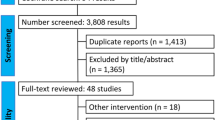Abstract
The purpose of this study was to determine, by means of a systematic review, whether the method of wound closure in complicated appendicitis affects the incidence of wound infection. A comprehensive literature search of multiple databases including MEDLINE (1980–2003), was performed, using the Cochrane search strategy, for articles on wound closure and complicated appendicitis. Clinical trials examining the method of wound closure were selected for systematic review and all quasi-randomized and randomized trials underwent meta-analysis. Failure to close the wound as planned in delayed closure (DC) was considered indicative of a wound infection. Purulent drainage requiring wound opening indicated an infection in the wounds closed primarily. Six randomized trials were considered adequate for meta-analysis. None independently showed a statistically significant difference in the risk of developing a wound infection with primary closure (PC). When pooled data were subjected to meta-analysis, PC achieved a statistically significant reduction in the relative risk of treatment failure and did not lead to an increase in wound infections. Primary closure does not increase the risk of developing a wound infection after operation for perforated appendicitis. Given the lack of benefit of DC, and the less traumatic, less painful, and less costly nature of PC; primary closure is a safe and practical treatment option.

Similar content being viewed by others
References
Janik JS, Firor HV (1979) Pediatric appendicitis: a 20-year study of 1640 children at Cook County (Illinois) Hospital. Arch Surg 114:717–720
Bower RJ, Bell MJ, Ternberg JL (1981) Controversial aspects of appendicitis management in children. Arch Surg 116:885–888
Schwartz MZ, Tapper D, Solenberger RI (1983) Management of perforated appendicitis in children: the controversy continues. Ann Surg 197:407–410
Schwartz SI (1994) Appendix. In: Schwartz SI (ed) Principles of surgery, 6th edn. McGraw-Hill, New York, pp 1307–1318
Liu CD, McFadden DW (1997) Acute abdomen and appendix. In: Greenfield LJ (ed) Surgery: scientific principles and practice, 3rd edn. JB Lippincott, Philadelphia, pp 1246–1261
Condon RE, Telford GL (1991) Appendicitis. In Sabiston DC (ed) Textbook of surgery, 14th edn. WB Saunders, Philadelphia, pp 884–898
David IB, Buck JR, Filler RM (1982) Rational use of antibiotics for perforated appendicitis in childhood. J Pediatr Surg 17:494–500
Karp MP, Caldarola VA, Cooney DR et al (1986) The avoidable excesses in the management of perforated appendicitis in children. J Pediatr Surg 21:506–511
Seco JL, Ojeda E, Reguilon C et al (1990) Combined topical and systemic antibiotic prophylaxis in acute appendicitis. Am J Surg 159:226–230
Burnweit C, Bilik R, Shandling B (2001) Primary closure of contaminated wounds in perforated appendicitis. J Pediatr Surg 26:1362–1365
Neilson IR, Laberge JM, Nguyen LT et al (1990) Appendicitis in children: current therapeutic recommendations. J Pediatr Surg 25:1113–1116
Curran TJ, Muenchow SK (1993) The treatment of complicated appendicitis in children using peritoneal drainage: results from a public hospital. J Pediatr Surg 28:204–206
Lund DP, Murphy EU (1994) Management of perforated appendicitis in children: a decade of aggressive treatment. J Pediatr Surg 29:1130–1134
Keller MS, McBride WJ, Vane DW (1996) Management of complicated appendicitis: a rational approach based on clinical course. Arch Surg 131:261–264
Serour F, Efrati Y, Klin B et al (1996) Subcuticular skin closure as a standard approach to emergency appendectomy in children: prospective clinical trial. World J Surg 20:38–42
Taylor E, Dev V, Shah D et al (2000) Complicated appendicitis: is there a minimum intravenous antibiotic requirement? A prospective randomized trial. Am Surg 66:887–90
Emil S, Laberge JM, Mikhail P et al (2003) Appendicitis in children: a ten-year update of therapeutic recommendations. J Pediatr Surg 38:236–42
Meier DE, Guzzetta PC, Barber RG et al (2003) Perforated appendicitis in children: is there a best treatment? J Pediatr Surg 38:1520–1524
Chen C, Botelho C, Cooper A et al (2003) Current practice patterns in the treatment of perforated appendicitis in children. J Am Coll Surg 196:212–221
Newman K, Ponsky T, Kittle K et al (2003) Appendicitis 2000: variability in practice, outcomes, and resource utilization at thirty pediatric hospitals. J Pediatr Surg 38:372–279
Jadad AR, Moore RA, Carroll D et al (1996) Assessing the quality of reports of randomized clinical trials: Is blinding necessary? Controlled Clin Trials 17:1–12
Deeks JJ, Altman DG, Bradburn MJ (2001) Statistical methods for examining heterogeneity and combining results from several studies in meta-analysis. In: Egger M, Smith GD, Altman DG (eds) Systematic reviews in health care: meta-analysis in context. BMJ Publishing Group, London, pp 285–312
Pettigrew RA (1981) Delayed primary wound closure in gangrenous and perforated appendicitis. Br J Surg 68:635–638
Tsang TM, Tam PKH, Saing H (1992) Delayed primary wound closure using skin tapes for advanced appendicitis in children. Arch Surg 127:451–453
Khammash MR, Ayyash K (1994) Wound infection in primary versus delayed primary wound closure in cases of perforated and gangrenous appendicitis. Saudi Med J 15:408–410
Cohn SM, Giannotti G, Ong AW et al (2001) Prospective randomized trial of two wound management strategies for dirty abdominal wounds. Ann Surg 233:409–413
Chatwiriyacharoen W (2002) Surgical wound infection post surgery in perforated appendicitis in children. J Med Assoc Thai 85:572–576
McGreal GT, Joy A, Manning B et al (2002) Antiseptic wick: does it reduce the incidence of wound infection following appendectomy? World J Surg 26:631–634
Rucinski J, Fabian T, Panagopoulos G et al (2000) Gangrenous and perforated appendicitis: a meta-analytic study of 2532 patients indicates that the incision should be closed primarily. Surgery 127:136–141
Author information
Authors and Affiliations
Corresponding author
Rights and permissions
About this article
Cite this article
Henry, M.C.W., Moss, R.L. Primary versus delayed wound closure in complicated appendicitis: an international systematic review and meta-analysis. Ped Surgery Int 21, 625–630 (2005). https://doi.org/10.1007/s00383-005-1476-8
Accepted:
Published:
Issue Date:
DOI: https://doi.org/10.1007/s00383-005-1476-8




